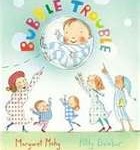 “Little Mabel blew a bubble, and it caused a lot of trouble…
“Little Mabel blew a bubble, and it caused a lot of trouble…
such a lot of bubble trouble in a bibble-bobble way.
For it broke away from Mabel as it bobbed across the table,
where it bobbled over Baby, and it wafted him away.”
I double-dog dare you to pick up Bubble Trouble (written by Margaret Mahy and illustrated by Polly Dunbar) and not read this tongue-twisting treat aloud. If you are an educator, we can babble and gabble about phonological awareness, the power of interesting rhyme to help young listeners hear the distinct sounds in words and therefore be better able to decode those words on a page, but frankly, the most important reason you could ever have to share this book with a listener of any age is simply for the pleasure of the patter.
After you and your kids have giggled and goggled until your brains are boggled (oh Margaret Mahy, I love you so), it’s the perfect lead-in to a science experiment with bubbles. There are a variety of homemade bubble solutions – most with dish soap, some with glycerin, some with corn syrup – and how fun would it be to test different solutions, or to vary the amount of one of the components to see how the bubbles are affected? What happens if you blow harder or softer? What if you blow through a square-shaped hole – could you make square bubbles?
If you can get your hands on Mercer Mayer’s wordless book Bubble Bubble, you’d have two fun, distinctly different books about bubbles to compare and contrast.
(For those of you who may be fretful and upset-ful about the baby in the bubble, fear not: thanks to pink and purple patchwork, the rebel treble Abel, and a well-aimed pebble, the baby boy rebounded to his mother’s safe embrace.)







